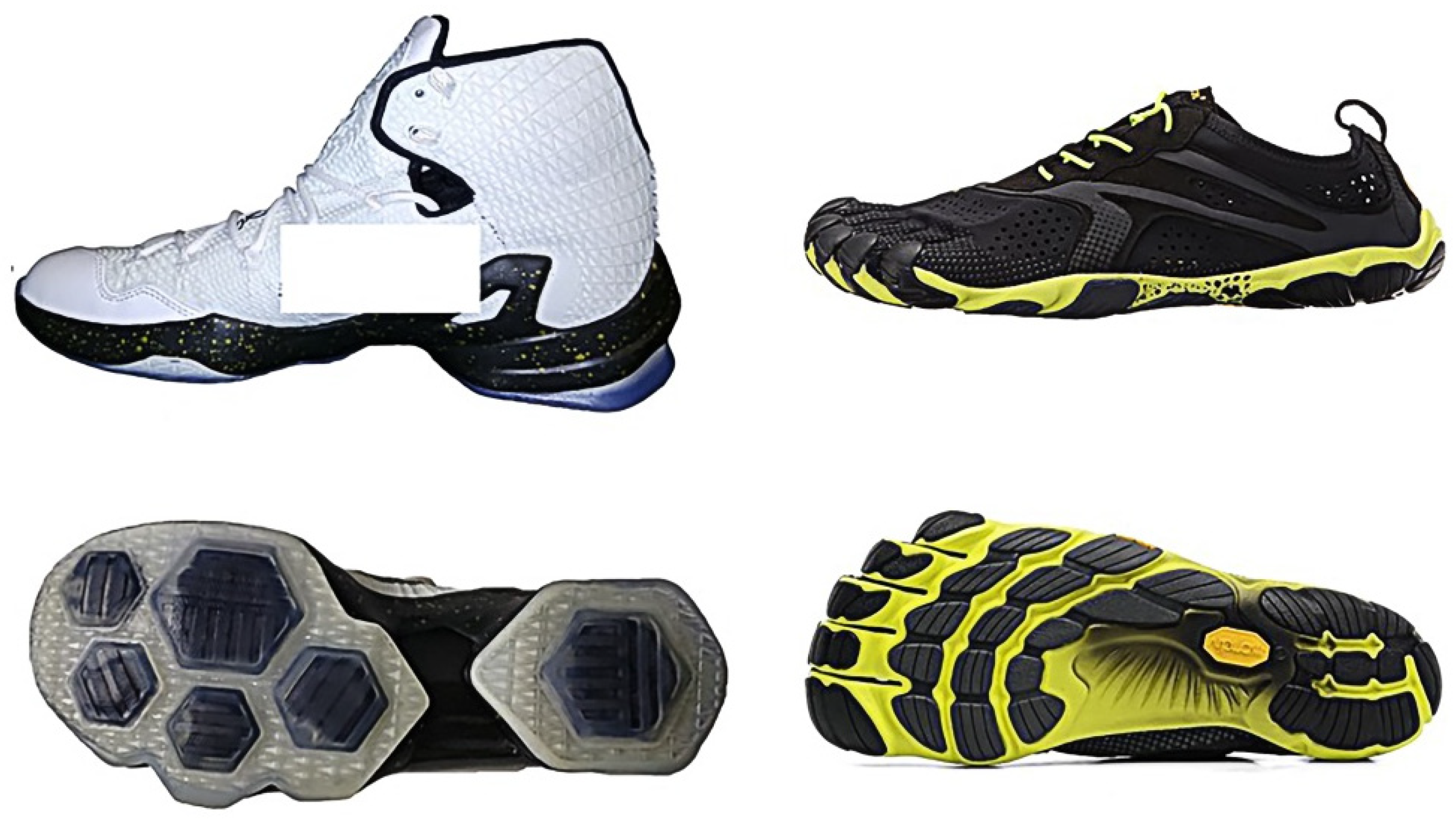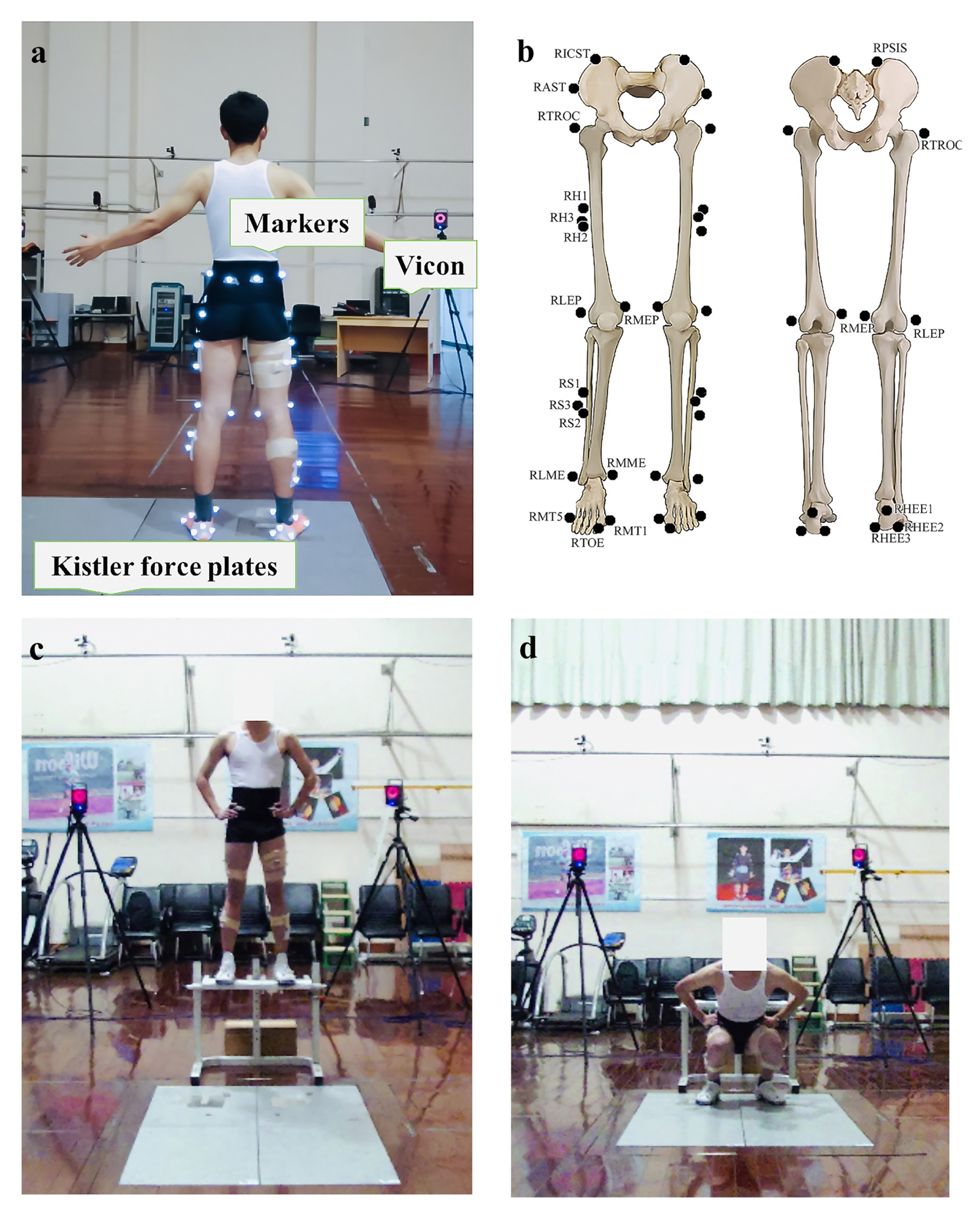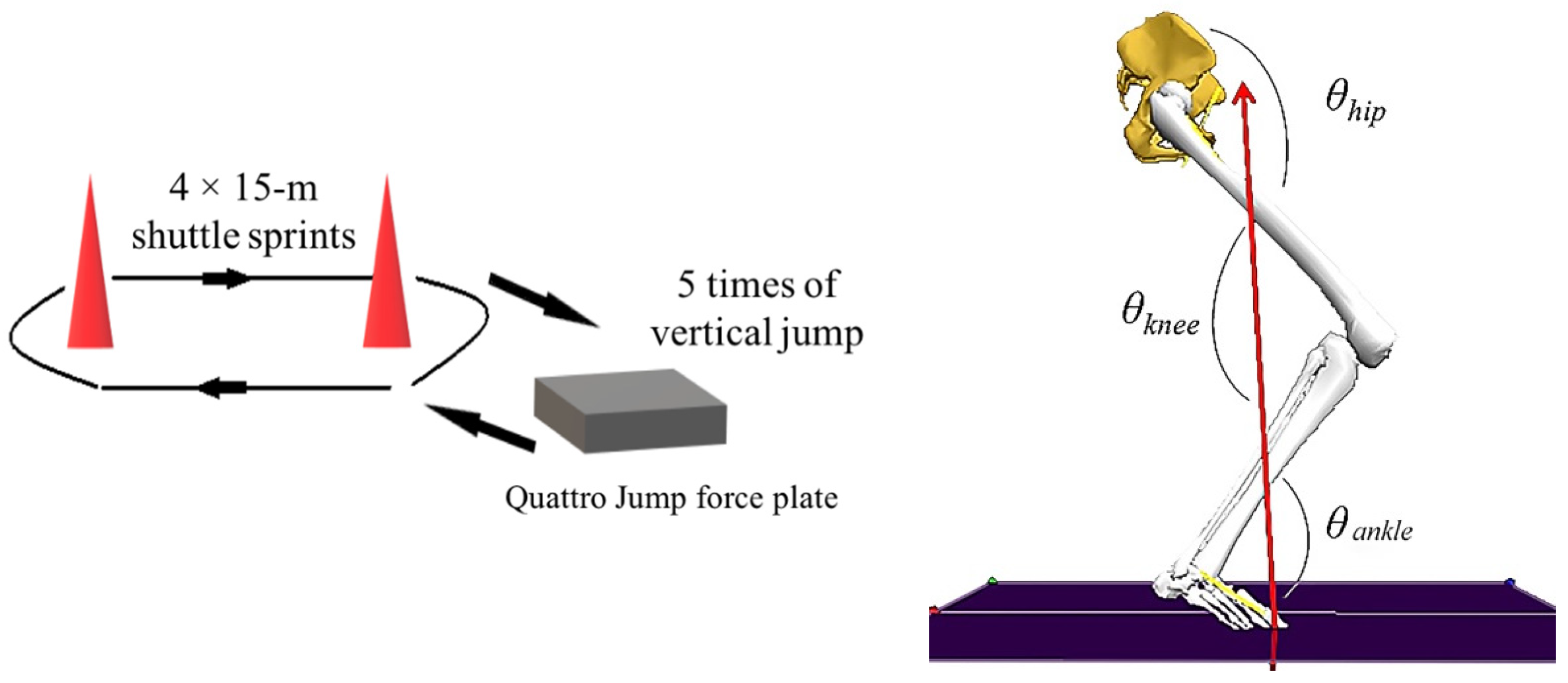Wearing Cushioning Shoes Reduce Load Rates More Effectively in Post-Fatigue than in Pre-Fatigue during Landings
Abstract
:Simple Summary
Abstract
1. Introduction
2. Materials and Methods
2.1. Participants
2.2. Experimental Shoes
2.3. Experimental Procedure
2.4. Acute Exercise-Induced Fatigue Protocol
2.5. Data Processing
2.6. Statistics
3. Results
3.1. Fatigue-Inducing Exercises
3.2. Impact Forces
3.3. Joint Kinematics
4. Discussion
4.1. Impact Forces
4.2. Joint Kinematics
5. Conclusions
Author Contributions
Funding
Institutional Review Board Statement
Informed Consent Statement
Data Availability Statement
Acknowledgments
Conflicts of Interest
References
- Lam, W.K.; Kan, W.H.; Chia, J.S.; Kong, P.W. Effect of shoe modifications on biomechanical changes in basketball: A systematic review. Sports Biomech. 2019, 1–27. [Google Scholar] [CrossRef]
- Zahradnik, D.; Jandacka, D.; Uchytil, J.; Farana, R.; Hamill, J. Lower extremity mechanics during landing after a volleyball block as a risk factor for anterior cruciate ligament injury. Phys. Ther. Sport 2015, 16, 53–58. [Google Scholar] [CrossRef]
- Dai, B.; Garrett, W.E.; Gross, M.T.; Padua, D.A.; Queen, R.M.; Yu, B. The effect of performance demands on lower extremity biomechanics during landing and cutting tasks. J. Sport Health Sci. 2019, 8, 228–234. [Google Scholar] [CrossRef] [PubMed] [Green Version]
- Podraza, J.; White, S. Effect of knee flexion angle on ground reaction forces, knee moments and muscle co-contraction during an impact-like deceleration landing: Implications for the non-contact mechanism of ACL injury. Knee 2010, 17, 291–295. [Google Scholar] [CrossRef] [PubMed]
- Lieberman, D.E.; Venkadesan, M.; Werbel, W.A.; Daoud, A.I.; D’Andrea, S.; Davis, I.S.; Mang’Eni, R.O.; Pitsiladis, Y. Foot strike patterns and collision forces in habitually barefoot versus shod runners. Nature 2010, 463, 531–535. [Google Scholar] [CrossRef]
- Fu, W.; Fang, Y.; Gu, Y.; Huang, L.; Li, L.; Liu, Y. Shoe cushioning reduces impact and muscle activation during landings from unexpected, but not self-initiated, drops. J. Sci. Med. Sport 2017, 20, 915–920. [Google Scholar] [CrossRef]
- Moody, D.; Hunter, I.; Ridge, S.; Myrer, J.W. Comparison of Varying Heel to Toe Differences and Cushion to Barefoot Running in Novice Minimalist Runners. Int. J. Exerc. Sci. 2018, 11, 13–19. [Google Scholar] [PubMed]
- Law, M.H.C.; Choi, E.M.F.; Law, S.H.Y.; Chan, S.S.C.; Wong, S.M.S.; Ching, E.C.K.; Chan, Z.Y.S.; Zhang, J.H.; Lam, G.W.K.; Lau, F.O.Y.; et al. Effects of footwear midsole thickness on running biomechanics. J. Sports Sci. 2019, 37, 1004–1010. [Google Scholar] [CrossRef]
- Sun, X.; Lam, W.K.; Zhang, X.; Wang, J.; Fu, W. Systematic Review of the Role of Footwear Constructions in Running Biomechanics: Implications for Running-Related Injury and Performance. J. Sports Sci. Med. 2020, 19, 20–37. [Google Scholar]
- Alonso-Montero, C.; Torres-Rubio, A.; Padrós-Flores, N.; Navarro-Flores, E.; Segura-Heras, J.V. Footprint Curvature in Spanish Women: Implications for Footwear Fit. Int. J. Environ. Res. Public Health 2020, 17, 1876. [Google Scholar] [CrossRef] [Green Version]
- Niu, W.; Feng, T.; Jiang, C.; Zhang, M. Peak vertical ground reaction force during two-leg landing: A systematic review and mathematical modeling. BioMed Res. Int. 2014, 2014, 126860. [Google Scholar] [CrossRef]
- Malisoux, L.; Gette, P.; Urhausen, A.; Bomfim, J.; Theisen, D. Influence of sports flooring and shoes on impact forces and performance during jump tasks. PLoS ONE 2017, 12, e0186297. [Google Scholar] [CrossRef] [Green Version]
- Qu, H.; Zhang, S.; Sorochan, J.C.; Weinhandl, J.T.; Thoms, A.W.; Dickson, K.H. Effects of synthetic turf and shock pad on impact attenuation related biomechanics during drop landing. Sports Biomech. 2020, 1–13. [Google Scholar] [CrossRef]
- Chatzistergos, P.E.; Gatt, A.; Formosa, C.; Farrugia, K.; Chockalingam, N. Optimised cushioning in diabetic footwear can significantly enhance their capacity to reduce plantar pressure. Gait Posture 2020, 79, 244–250. [Google Scholar] [CrossRef]
- McLaughlin, P.; Chowdary, P.; Woledge, R.; McCarthy, A.; Mayagoitia, R. The effect of neutral-cushioned running shoes on the intra-articular force in the haemophilic ankle. Clin. Biomech. 2013, 28, 672–678. [Google Scholar] [CrossRef]
- Nigg, B.M.; Baltich, J.; Maurer, C.; Federolf, P. Shoe midsole hardness, sex and age effects on lower extremity kinematics during running. J. Biomech. 2012, 45, 1692–1697. [Google Scholar] [CrossRef] [PubMed] [Green Version]
- Kerdok, A.E.; Biewener, A.A.; McMahon, T.A.; Weyand, P.G.; Herr, H.M. Energetics and mechanics of human running on surfaces of different stiffnesses. J. Appl. Physiol. 2002, 92, 469–478. [Google Scholar] [CrossRef] [PubMed] [Green Version]
- Nigg, B.M.; Stergiou, P.; Cole, G.; Stefanyshyn, D.; Mundermann, A.; Humble, N. Effect of shoe inserts on kinematics, center of pressure, and leg joint moments during running. Med. Sci. Sports Exerc. 2003, 35, 314–319. [Google Scholar] [CrossRef] [Green Version]
- Fong Yan, A.; Sinclair, P.J.; Hiller, C.; Wegener, C.; Smith, R.M. Impact attenuation during weight bearing activities in barefoot vs. shod conditions: A systematic review. Gait Posture 2013, 38, 175–186. [Google Scholar] [CrossRef]
- Nin, D.Z.; Lam, W.K.; Kong, P.W. Effect of body mass and midsole hardness on kinetic and perceptual variables during basketball landing manoeuvres. J. Sports Sci. 2016, 34, 756–765. [Google Scholar] [CrossRef] [PubMed]
- Mohr, M.; Trudeau, M.B.; Nigg, S.R.; Nigg, B.M. Increased Athletic Performance in Lighter Basketball Shoes: Shoe or Psychology Effect? Int. J. Sports Physiol. Perform. 2016, 11, 74–79. [Google Scholar] [CrossRef]
- Lam, W.K.; Lee, W.C.; Ng, S.O.; Zheng, Y. Effects of foot orthoses on dynamic balance and basketball free-throw accuracy before and after physical fatigue. J. Biomech. 2019, 96, 109338. [Google Scholar] [CrossRef] [PubMed]
- Chatzinikolaou, A.; Draganidis, D.; Avloniti, A.; Karipidis, A.; Jamurtas, A.Z.; Skevaki, C.L.; Tsoukas, D.; Sovatzidis, A.; Theodorou, A.; Kambas, A.; et al. The microcycle of inflammation and performance changes after a basketball match. J. Sports Sci. 2014, 32, 870–882. [Google Scholar] [CrossRef] [PubMed]
- Enoka, R. Muscle fatigue—From motor units to clinical symptom. J. Biomech. 2012, 45, 427–433. [Google Scholar] [CrossRef]
- Chappell, J.D.; Herman, D.C.; Knight, B.S.; Kirkendall, D.T.; Garrett, W.E.; Yu, B. Effect of fatigue on knee kinetics and kinematics in stop-jump tasks. Am. J. Sports Med. 2005, 33, 1022–1029. [Google Scholar] [CrossRef]
- Vercruyssen, F.; Tartaruga, M.; Horvais, N.; Brisswalter, J. Effects of Footwear and Fatigue on Running Economy and Biomechanics in Trail Runners. Med. Sci. Sports Exerc. 2016, 48, 1976–1984. [Google Scholar] [CrossRef] [PubMed]
- Speed, G.; Harris, K.; Keegel, T. The effect of cushioning materials on musculoskeletal discomfort and fatigue during prolonged standing at work: A systematic review. Appl. Ergon. 2018, 70, 300–314. [Google Scholar] [CrossRef]
- Moon, J.; Pathak, P.; Kim, S.; Roh, S.G.; Roh, C.; Shim, Y.; Ahn, J. Shoes with active insoles mitigate declines in balance after fatigue. Sci. Rep. 2020, 10, 1951. [Google Scholar] [CrossRef] [PubMed] [Green Version]
- Faul, F.; Erdfelder, E.; Lang, A.G.; Buchner, A. G*Power 3: A flexible statistical power analysis program for the social, behavioral, and biomedical sciences. Behav. Res. Methods 2007, 39, 175–191. [Google Scholar] [CrossRef]
- Zhang, X.; Xia, R.; Dai, B.; Sun, X.; Fu, W. Effects of Exercise-Induced Fatigue on Lower Extremity Joint Mechanics, Stiffness, and Energy Absorption during Landings. J. Sports Sci. Med. 2018, 17, 640–649. [Google Scholar] [PubMed]
- Wei, Q.; Wang, Z.; Woo, J.; Liebenberg, J.; Park, S.K.; Ryu, J.; Lam, W.K. Kinetics and perception of basketball landing in various heights and footwear cushioning. PLoS ONE 2018, 13, e0201758. [Google Scholar] [CrossRef] [PubMed]
- Xia, R.; Zhang, X.; Wang, X.; Sun, X.; Fu, W. Effects of Two Fatigue Protocols on Impact Forces and Lower Extremity Kinematics during Drop Landings: Implications for Noncontact Anterior Cruciate Ligament Injury. J. Healthc. Eng. 2017, 2017, 5690519. [Google Scholar] [CrossRef] [Green Version]
- Ramos-Campo, D.J.; Rubio-Arias, J.A.; Avila-Gandia, V.; Marin-Pagan, C.; Luque, A.; Alcaraz, P.E. Heart rate variability to assess ventilatory thresholds in professional basketball players. J. Sport Health Sci. 2017, 6, 468–473. [Google Scholar] [CrossRef] [PubMed] [Green Version]
- Fu, W.; Liu, Y.; Zhang, S. Effects of footwear on impact forces and soft tissue vibrations during drop jumps and unanticipated drop landings. Int. J. Sports Med. 2013, 34, 477–483. [Google Scholar] [CrossRef] [PubMed]
- Munro, B.H.; Visintainer, M.A. Statistical Methods for Health Care Research; Lippincott Williams and Wilkins: Philadelphia, PA, USA, 1986. [Google Scholar]
- Milani, T.L.; Hennig, E.M.; Lafortune, M.A. Perceptual and biomechanical variables for running in identical shoe constructions with varying midsole hardness. Clin. Biomech. 1997, 12, 294–300. [Google Scholar] [CrossRef]
- Lam, W.K.; Liu, H.; Wu, G.Q.; Liu, Z.L.; Sun, W. Effect of shoe wearing time and midsole hardness on ground reaction forces, ankle stability and perceived comfort in basketball landing. J. Sports Sci. 2019, 37, 2347–2355. [Google Scholar] [CrossRef] [PubMed]
- Lareau, C.R.; Sawyer, G.A.; Wang, J.H.; DiGiovanni, C.W. Plantar and medial heel pain: Diagnosis and management. J. Am. Acad. Orthop. Surg. 2014, 22, 372–380. [Google Scholar] [CrossRef]
- Clansey, A.C.; Hanlon, M.; Wallace, E.S.; Lake, M.J. Effects of fatigue on running mechanics associated with tibial stress fracture risk. Med. Sci. Sports Exerc. 2012, 44, 1917–1923. [Google Scholar] [CrossRef]
- Hreljac, A.; Marshall, R.N.; Hume, P.A. Evaluation of lower extremity overuse injury potential in runners. Med. Sci. Sports Exerc. 2000, 32, 1635–1641. [Google Scholar] [CrossRef] [Green Version]
- Chua, Y.K.; Quek, R.K.; Kong, P.W. Basketball lay-up—Foot loading characteristics and the number of trials necessary to obtain stable plantar pressure variables. Sports Biomech. 2017, 16, 13–22. [Google Scholar] [CrossRef]
- Orendurff, M.S.; Rohr, E.S.; Segal, A.D.; Medley, J.W.; Green, J.R., 3rd; Kadel, N.J. Regional foot pressure during running, cutting, jumping, and landing. Am. J. Sports Med. 2008, 36, 566–571. [Google Scholar] [CrossRef] [PubMed]
- Zhang, X.N.; Luo, Z.; Wang, X.; Yang, Y.; Niu, J.X.; Fu, W.J. Shoe Cushioning Effects on Foot Loading and Comfort Perception during Typical Basketball Maneuvers. Appl. Sci. 2019, 9, 3893. [Google Scholar] [CrossRef] [Green Version]
- Bates, N.A.; Ford, K.R.; Myer, G.D.; Hewett, T.E. Timing differences in the generation of ground reaction forces between the initial and secondary landing phases of the drop vertical jump. Clin. Biomech. 2013, 28, 796–799. [Google Scholar] [CrossRef] [Green Version]
- Yang, Y.; Fang, Y.; Zhang, X.; He, J.; Fu, W. Does Shoe Collar Height Influence Ankle Joint Kinematics and Kinetics in Sagittal Plane Maneuvers? J. Sports Sci. Med. 2017, 16, 543–550. [Google Scholar]
- Whyte, E.F.; Kennelly, P.; Milton, O.; Richter, C.; O’Connor, S.; Moran, K.A. The effects of limb dominance and a short term, high intensity exercise protocol on both landings of the vertical drop jump: Implications for the vertical drop jump as a screening tool. Sports Biomech. 2018, 17, 541–553. [Google Scholar] [CrossRef] [PubMed]
- Kernozek, T.W.; Torry, M.R.; Iwasaki, M. Gender differences in lower extremity landing mechanics caused by neuromuscular fatigue. Am. J. Sports Med. 2008, 36, 554–565. [Google Scholar] [CrossRef] [PubMed]





| Variables | Pre-Fatigue | Post-Fatigue | ICC | CI 95% | ||||
|---|---|---|---|---|---|---|---|---|
| HS | CS | HS | CS | |||||
| vGRF | Fz1max (BW) | 1.2 ± 0.3 | 1.1 ± 0.3 | 1.3 ± 0.3 | 1.2 ± 0.3 | 0.913 | 0.809 | 0.967 |
| tFz1 (ms) | 12.0 ± 2.6 * | 10.2 ± 3.5 | 12.8 ± 2.5 *,# | 10.1 ± 3.6 | 0.882 | 0.742 | 0.956 | |
| Fz2max (BW) | 3.8 ± 0.8 * | 4.4 ± 1.0 | 3.8 ± 0.9 * | 4.5 ± 1.0 | 0.803 | 0.568 | 0.926 | |
| tFz2 (ms) | 35.5 ± 10.3 * | 40.4 ± 10.8 | 41.6 ± 7.3 # | 41.0 ± 10.4 | 0.913 | 0.810 | 0.967 | |
| LR | G1max (BW·s−1) | 199.2 ± 44.1 | 257.4 ± 65.0 | 194.5 ± 40.5 * | 267.0 ± 60.2 | 0.693 | 0.308 | 0.89 |
| tG1 (ms) | 6.7 ± 2.3 | 7.0 ± 3.6 | 8.0 ± 2.8 # | 6.9 ± 4.0 # | 0.877 | 0.732 | 0.956 | |
| G2max (BW·s−1) | 389.7 ± 115.5 * | 688.0 ± 281.4 | 375.5 ± 136.6 * | 756.8 ± 260.0 | 0.766 | 0.482 | 0.912 | |
| tG2 (ms) | 29.9 ± 10.2 * | 36.6 ± 10.7 | 36.4 ± 7.8 # | 37.1 ± 10.1 | 0.915 | 0.814 | 0.968 | |
| Joint | Variables | Pre-Fatigue | Post-Fatigue | ICC | CI 95% | |||
|---|---|---|---|---|---|---|---|---|
| HS | CS | HS | CS | |||||
| Hip | θcont (°) | 139.4 ± 5.9 * | 143.4 ± 7.0 | 141.2 ± 7.2 | 143.3 ± 7.4 | 0.815 | 0.594 | 0.931 |
| θmin (°) | 86.3 ± 12.5 | 87.2 ± 11.2 | 88.8 ± 11.1 | 86.6 ± 11.0 | 0.921 | 0.826 | 0.970 | |
| RoMhip (°) | 53.1± 13.2 | 56.2 ± 13.4 | 52.4 ± 12.3 * | 56.7 ± 9.8 | 0.944 | 0.878 | 0.979 | |
| Knee | θcont (°) | 158.6 ± 7.2 * | 161.8 ± 5.6 | 160.3 ± 8.8 | 161.7 ± 5.7 | 0.888 | 0.755 | 0.958 |
| θmin (°) | 72.0 ± 21.0 * | 77.7 ± 17.0 | 74.7 ± 22.6 | 76.1 ± 18.6 | 0.979 | 0.954 | 0.992 | |
| RoMknee (°) | 86.6 ± 18.0 | 84.1 ± 16.9 | 85.4 ± 23.1 | 85.6 ± 17.1 | 0.944 | 0.881 | 0.978 | |
| Ankle | θcont (°) | 126.5 ± 10.0 # | 128.1 ± 8.1 | 131.7 ± 8.4 | 129.8 ± 6.9 | 0.923 | 0.831 | 0.971 |
| θmin (°) | 84.7 ± 7.2 # | 84.5 ± 5.3 | 87.0 ± 7.8 | 85.2 ± 6.9 | 0.971 | 0.937 | 0.989 | |
| RoMankle (°) | 41.8 ± 9.8 | 43.6 ± 8.3 | 43.3 ± 11.9 | 44.6 ± 7.7 | 0.923 | 0.832 | 0.971 | |
Publisher’s Note: MDPI stays neutral with regard to jurisdictional claims in published maps and institutional affiliations. |
© 2021 by the authors. Licensee MDPI, Basel, Switzerland. This article is an open access article distributed under the terms and conditions of the Creative Commons Attribution (CC BY) license (https://creativecommons.org/licenses/by/4.0/).
Share and Cite
Wang, X.; Deng, L.; Lam, W.-K.; Yang, Y.; Zhang, X.; Fu, W. Wearing Cushioning Shoes Reduce Load Rates More Effectively in Post-Fatigue than in Pre-Fatigue during Landings. Biology 2021, 10, 962. https://doi.org/10.3390/biology10100962
Wang X, Deng L, Lam W-K, Yang Y, Zhang X, Fu W. Wearing Cushioning Shoes Reduce Load Rates More Effectively in Post-Fatigue than in Pre-Fatigue during Landings. Biology. 2021; 10(10):962. https://doi.org/10.3390/biology10100962
Chicago/Turabian StyleWang, Xi, Liqin Deng, Wing-Kai Lam, Yang Yang, Xini Zhang, and Weijie Fu. 2021. "Wearing Cushioning Shoes Reduce Load Rates More Effectively in Post-Fatigue than in Pre-Fatigue during Landings" Biology 10, no. 10: 962. https://doi.org/10.3390/biology10100962






